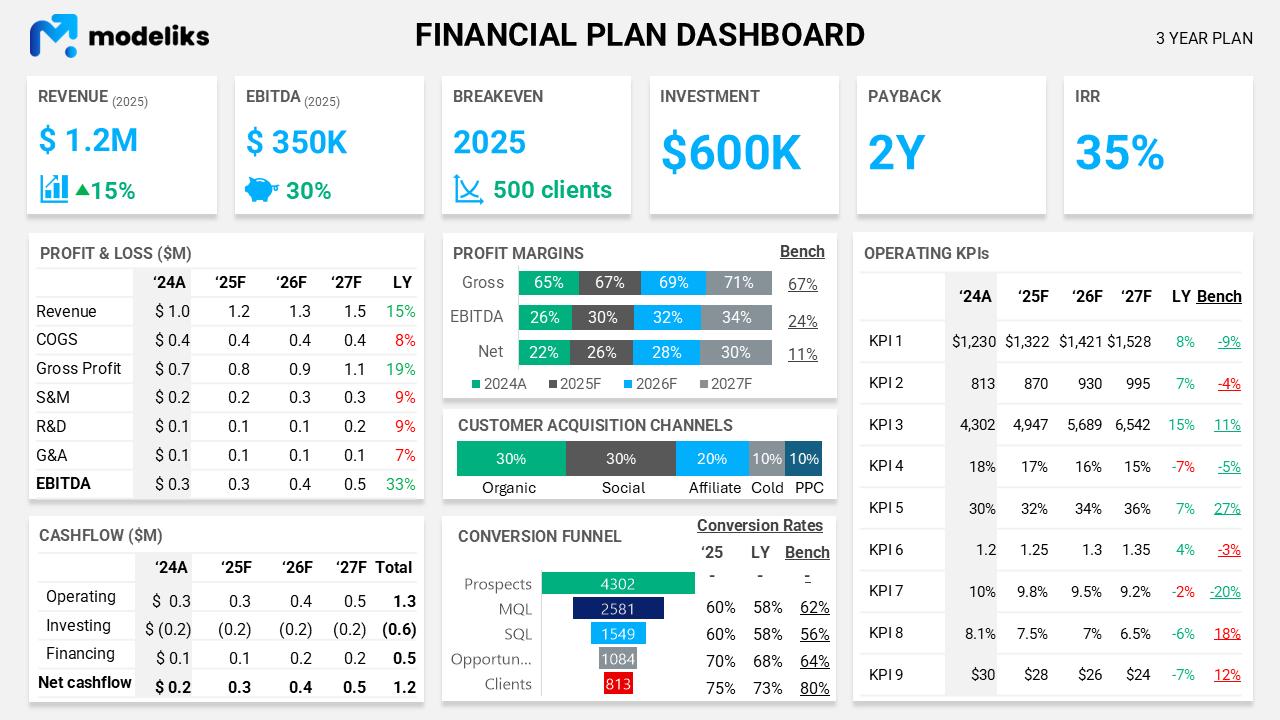Our Immigration Legal Services Financial Model Structure covers all the essential aspects you need to consider when starting or scaling a Immigration Legal Services business. By following this structure, you can better understand your revenue streams, costs, and assets, helping you optimize profitability and strategically plan for growth.
Financial planning for an Immigration Legal Services business requires a comprehensive understanding of various elements that contribute to its operational and economic viability. Crafting a dedicated financial model for this type of business highlights essential revenues, direct costs, personnel, expenses, and assets. These are fundamental when starting or expanding your practice. This model not only assists in organizing your current financial outlook, but it also aids in exploring new and potentially profitable revenue streams. The Immigration Legal Services financial model structure is crucial because it provides a framework for decision-making, although challenges may arise during implementation.
The Immigration Legal Services Financial Model Structure
a. Revenues
The typical revenue streams for an Immigration Legal Services business include:
- Consultation Fees: This revenue is generated from initial client consultations, calculated by multiplying the average fee per consultation by the number of consultations per period.
- Visa Application Services: Represent income derived from assisting clients with visa applications. This is calculated by the number of applications processed times the average fee per application.
- Legal Representation: Involves fees received for representing clients in legal proceedings, calculated by multiplying the number of cases handled by the average fee per case.
- Documentation Assistance: Generates revenue from helping clients gather and prepare necessary documents, calculated by the number of documentation requests times the average fee for this service.
- Translation Services: Produce earnings from providing language translation services, calculated as the number of translation jobs multiplied by the average fee per job.
- Retainer Services: Consist of monthly or yearly payments received from clients for ongoing services, calculated by multiplying the number of retainer agreements by their average fee.
- Workshop/Training Fees: Income derived from hosting educational workshops; this is calculated by multiplying the number of participants by the fee per participant.
- Notarial Services: Fees earned from notarizing documents, calculated as the number of documents notarized times the fee per document.
However, this process can become complex, because various factors influence the final amount. Although the calculations seem straightforward, minor errors can lead to discrepancies in the fees charged.
b. Cost of Goods Sold
The costs of goods sold (COGS) in an Immigration Legal Services business involve costs directly associated with delivering these services:
- Consultation Costs: Incurred during client consultations, including printed materials or meeting space rental.
- Application Processing Fees: Paid to government entities for application processing.
- Legal Research and Documentation: Fees for accessing legal databases and acquiring necessary documentation.
- Translation Costs: Expenses for outsourcing translation services or purchasing translation software.
However, these expenses can vary significantly. Although the nature of these costs is predictable, fluctuations in demand can affect overall profitability. This is especially true in competitive markets, where margins may be tighter. Because of this, careful financial planning is essential for sustainability.
c. Employees
Typical employees in an Immigration Legal Services business might include:
- Immigration Attorneys: Responsible for providing legal advice and representation.
- Paralegals: Assist attorneys in client management and documentation.
- Administrative Staff: Manage office operations, client scheduling, and billing.
- Marketing Specialist: Develops and implements marketing strategies to attract clients.
- Financial Manager: Handles budgeting, accounting, and financial strategy.
This array of roles is crucial because each position contributes to the overall effectiveness of the firm. Although they have distinct responsibilities, collaboration is essential for success.
d. Operating Expenses
The typical operating expenses include:
- Rent: Costs for office space rental.
- Salaries and Wages: Payroll expenses for staff.
- Utilities: Payments for water, electricity, and internet.
- Marketing Expenses: Costs associated with online and offline marketing initiatives.
- Office Supplies: Expenses for daily office necessities.
- Technology and Software: Purchase of software and technology services.
- Insurance: Payments for liability and business insurance.
- Professional Development: Training and certification costs for staff.
- Networking Events: Participation fees for industry events and conferences.
- Accounting and Legal Fees: Costs incurred for external accounting and legal services.
These may vary depending on the provider.
e. Assets
Typical assets include:
- Office Furniture and Equipment: Desks, chairs, computers, and other essential items.
- Legal Software: Specialized software for case management and legal research.
- Vehicles: If applicable, used for business purposes.
This diversity in resources is important because it caters to different needs within an organization.
f. Funding Options
Common funding options include:
- Personal Savings: Using personal funds to initiate the business can be a viable option.
- Bank Loans: Traditional loans from financial institutions are also commonly considered.
- Angel Investors: Offer investment from private individuals seeking equity, although they may require substantial returns.
- Government Grants: Provide funding from government programs, but they often come with specific conditions.
- Venture Capital: Another source of investment, coming from firms specializing in startup financing. This type of funding can significantly accelerate growth.
The Financial Plan Output
The objective of the financial forecast outputs is to enable you, your management, board, or investors to quickly comprehend how your Immigration Legal Services enterprise will perform in the future. This assessment should provide assurance that the plan is not only well thought out but also realistic and attainable. Furthermore, it is essential to understand the investment required to implement this plan and what the anticipated return on investment will be.
To accomplish these aims, here is a one-page template detailing how to effectively present your financial plan.

In addition to this summary, you will need three projected financial statements:
- Profit and Loss: Showcases revenue, costs, and expenses to indicate profitability over time.
- Balance Sheet: Provides a snapshot of the business’s financial position, listing assets, liabilities, and equity.
- Cash Flow Statement: Tracks cash inflows and outflows to ensure liquidity is maintained.
However, keep in mind that clarity and precision in these documents are crucial, because they will ultimately support your strategic decisions.
Need a financial model?
Create one with Modeliks and be confident in your numbers!
Manage & Grow with us!
Immigration Legal Services Financial Model Summary
A professional Immigration Legal Services financial model will assist you in thinking through your business strategy; it helps identify the resources needed to achieve your targets. You can set achievable goals, measure performance, raise necessary funding, and make confident decisions to manage and grow your business. This model is not merely a financial guide—it is a crucial tool for strategic planning and successful entrepreneurship in the immigration services sector. However, because of its importance, many overlook its potential. Although it may seem daunting at first, embracing this model can lead to significant advantages.
If you need help with your financial plan, try Modeliks , a financial planning solution for SMEs and startups or contact us at contact@modeliks.com and we can help.
Author:
Blagoja Hamamdjiev
, Founder and CEO of
Modeliks
, Entrepreneur, and business planning expert.
In the last 20 years, he helped everything from startups to multi-billion-dollar conglomerates plan, manage, fundraise, and grow.

TAKE MODELIKS FOR A SPIN
Not sure which plan?
Start with a 15 days free trial.
You will have access to the full functionality of Modeliks. The only restriction in the free trial is that you cannot download or share your business plan outside Modeliks. Credit card is not required to subscribe for the free trial.





